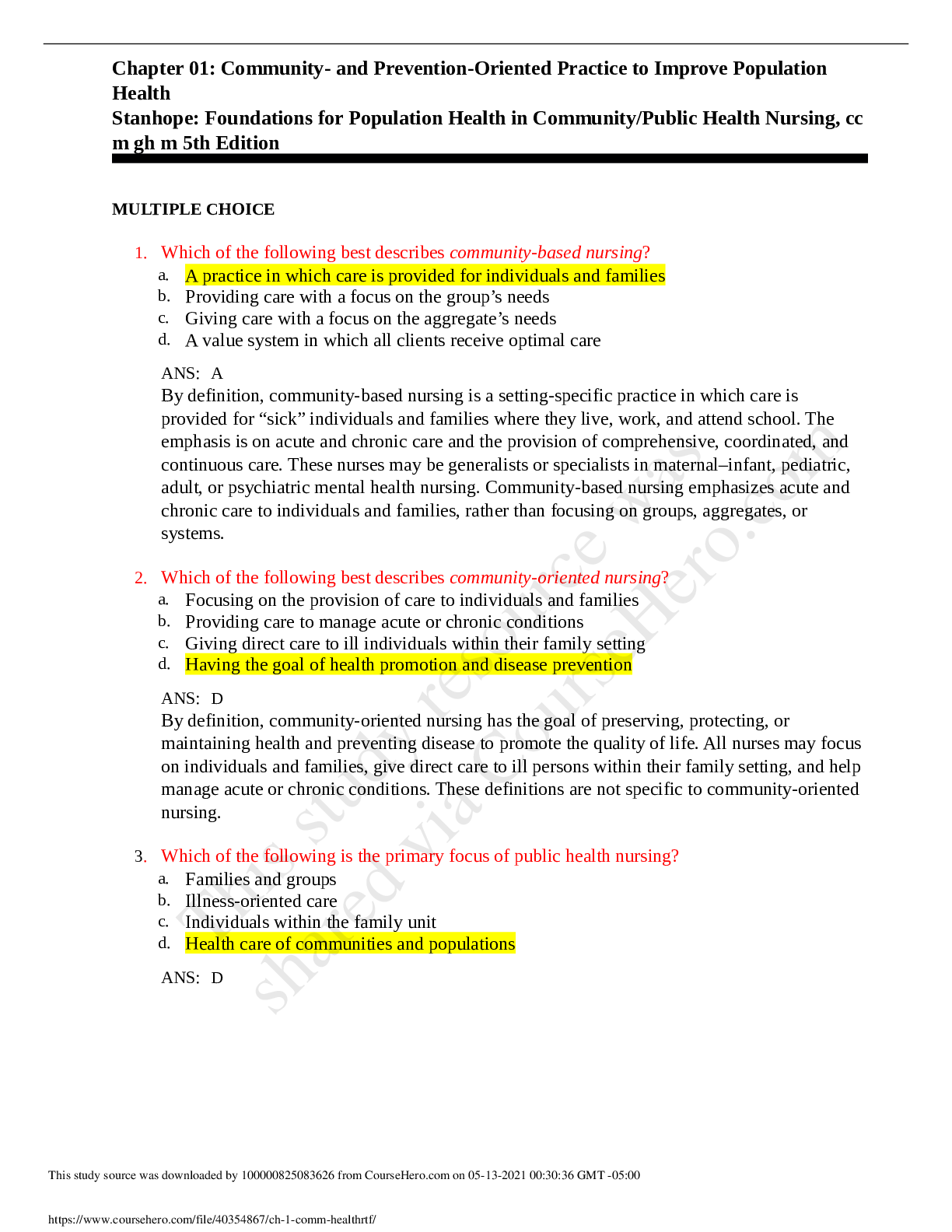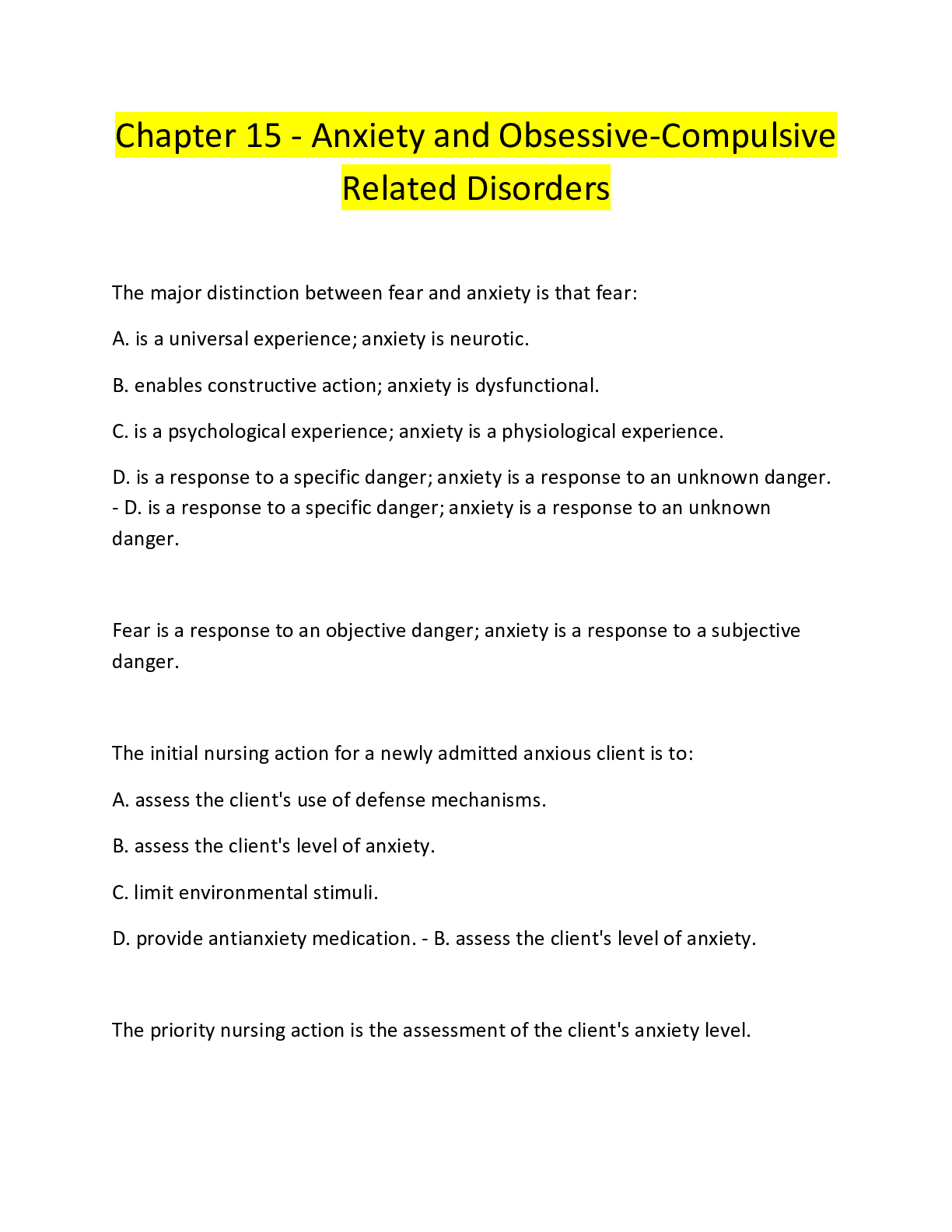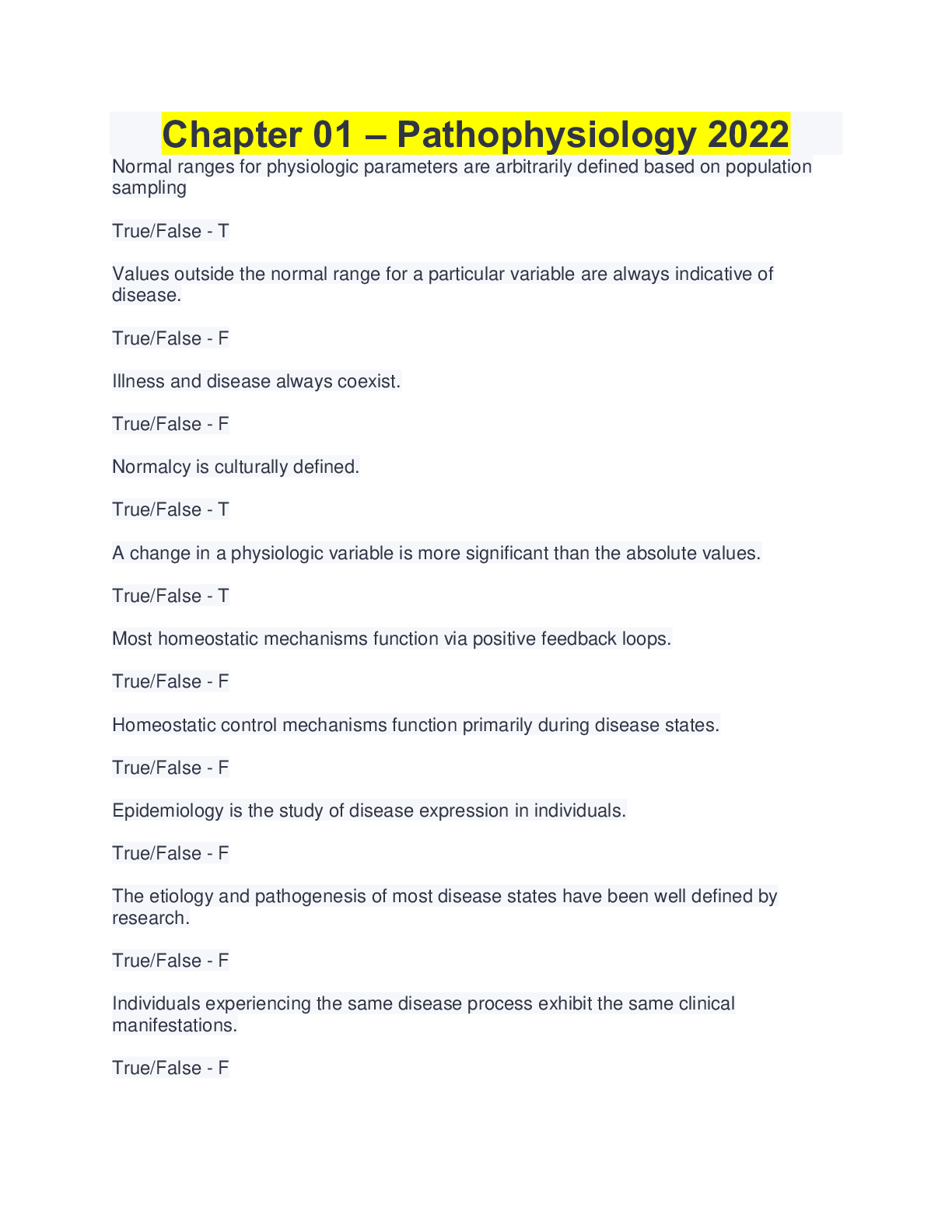*NURSING > EXAM > Rural Health and Migrant Healt Stanhope: Foundations of Population Health for Community/Public Healt (All)
Rural Health and Migrant Healt Stanhope: Foundations of Population Health for Community/Public Health Nursing, 5th Edition,100% CORRECT
Document Content and Description Below
Rural Health and Migrant Healt Stanhope: Foundations of Population Health for Community/Public Health Nursing, 5th Edition MULTIPLE CHOICE 1. A resident in a rural community has been diagnosed... with asthma. Which of the following providers will most likely provide care to this client? a. Advanced nurse practitioner b. Allergist c. Pediatrician d. Pulmonologist ANS: A The providers most often seen by rural adults are general practitioners and advanced practice registered nurses (APRNs). Most urban adults are more likely to seek care from a medical specialist (allergist or pulmonologist). A pediatrician would provide care specific to children which may or may not be appropriate depending on the age of the resident. 2. Which of the following best describes a health professional shortage area (HPSA)? a. An area with inadequate health care facilities for residents b. An isolated area of underserved populations within an urban region c. A region with insufficient numbers of health care providers d. A rural region of the United States with a population density of less than 10,000 ANS: C N R I G B.C M An HPSA is a geographical areUa thSat hNas iTnsufficiOent numbers of health professionals according to criteria established by the federal government. Often rural areas have a physician, nurse practitioner, or nurse in community health who provides services to residents who live in several counties. The incorrect responses do not fit the definition of a HPSA. 3. A migrant farmworker has been injured while working on the farm. Which of the following would provide assistance to care for this injury? a. Emergency department for immediate care b. Migrant Health Act clinics c. OSHA, because the man was injured by farm machinery d. Workers’ Compensation, because injury was at work ANS: A The only source the nurse can count on using is sending injured workers to emergency departments for immediate care. Farming and ranching do not often fall under OSHA guidelines, because they are considered small enterprises. Therefore, safety standards are not enforceable, nor is Workers’ Compensation insurance usually available for the agricultural industry. Although there are migrant health clinics, they are not always geographically convenient. 4. A nurse is caring for a migrant farm worker who has been working in the agricultural industry for the past 10 years. When questioned about environmental hazards, the client reports regular exposure to pesticides. Which of the following disorders is the client most at risk to develop? a. Cancer b. Memory loss c. Skin rashes d. Headaches ANS: A Chronic exposure to pesticides and chemicals may lead to cancer. Memory loss, skin rashes, and headaches are all potential side effects of short term exposure to pesticides and chemicals. 5. A migrant farmworker presents to the clinic reporting an acute onset of severe abdominal pain, nausea, vomiting, diarrhea, and headache with difficulty concentrating. Which of the following conditions would cause such symptoms? a. Appendicitis b. Bacterial gastroenteritis c. Pesticide poisoning d. Viral illness ANS: C Because a migrant farmworker is employed in agriculture, the most probable cause is pesticide poisoning. Acute health effects of pesticide exposure include mild psychological and behavioral deficits such as memory loss, difficulty with concentration, and mood changes, abdominal pain, nausea, vomiting, diarrhea, headache, malaise, skin rashes, and eye irritation. The work setting of a migrant farmer would lead the nurse to first consider pesticide poisoining as a potential underlying cause of these symptoms. However, some of these symptoms could potentially be present with appendicitis, bacterial gastroenteritis, or a viral illness. 6. In addition to those barriers faced by many residents in rural areas, what additional barrier to health care is a Hispanic migNraUntRfSarImNwGorTkeBr .likCeOlyMto encounter? a. Absence of culturally competent care b. Availability of specialists c. Distance of health care facilities from the place of residence d. High cost of health care ANS: A For migrant workers, a language barrier and cultural differences often exist between them and other area residents, including health care providers. This is an additional barrier that is not faced by other rural residents. Barriers to health care in general affecting all populations include whether services and professionals are available, affordable, or accessible to rural consumers, not just migrant workers. 7. Which of the following is the most accurate description of a migrant farmworker? a. A person who does farm work as the primary means of employment, although other work may be done when the seasonal work ends b. A person who immigrates to the United States to “follow the crops” in performing seasonal farm work c. A person who moves from place to place to earn money performing seasonal agricultural work d. A person who specializes in the development of rural land for the purpose of farming ANS: C The Office of Migrant Health of the U.S. Public Health Service defines a migrant farmworker as a person “whose principal employment is in agriculture on a seasonal basis, who has been so employed within the last 24 months, and who establishes for the purpose of such employment a temporary abode.” The emphasis in the definition of migrant farmworkers is on moving (temporary abode), farm work, and seasonal basis. Not all migrant farmworkers are immigrants. 8. An employer provides a migrant farm family the day off to visit the health clinic in a nearby community and tells them to take all of the time they need. However, the family arrives at the clinic appearing very stressed. In addition to the health issue, which of the following would most likely be a fear experienced by the family? a. Their personal belongings may be stolen while they are at the clinic. b. Immigration officials will send them back to their home country. c. The clinic personnel will look down on them and be biased against them. d. They weren’t getting paid for that day, and continued employment is never certain. ANS: D Migrant farmworkers often have an unpredictable and difficult lifestyle. Many must leave home each year and travel to distant locations to work. They may be uncertain about their work and housing as they go from one possible job to another. An employer telling them to “take all the time they want” could be interpreted as meaning they may no longer be needed, and their next job may be very uncertain. Most migrant farmworkers are legal residents or U.S. citizens, not illegal immigrants. If the clinic personnel provide culturally competent care, they should not be biased or look down on this family when providing care. They should not be at any greater risk to have their belongings be stolen than on any other day when they leave their home. N R I G B.C M 9. A migrant farmworker brings his daughter to the clinic with severe heat stroke from being out in the sun. The nurse explains the danger signs and stresses staying cool and drinking lots of water. The man seems to know this already. Which of the following best describes the most likely reason that this happened? a. It was a rare occurrence, which probably won’t be repeated. b. The daughter either disobeyed her father and went out to play in the sun or just did not realize how hot she was. c. Children may work on small farms because the family may need the additional income. d. The parents were busy working and didn’t realize the child was outside so long. ANS: C Children 12 to 13 years of age can work on a farm with the parents’ consent or if the parent works on the same farm. Children younger than 12 years can work on a farm with fewer than 7 full-time workers. Children may need to work for the family’s economic survival. This child may be at risk for this occurring again because the family needs the income that is generated by the child’s employment. The child is most likely working and not going outside to play. In order for this child to work, the parents also were working on the same farm with them, but again need this child’s income for survival. 10. A nurse is working with Mexican immigrants. Which of the following behaviors would most likely lead to a positive interaction for the nurse? a. Avoiding touching the client except when necessary as part of the physical examination b. Calling the client by name, socializing before addressing the problem, and being very respectful c. Keeping all interactions direct, to the point, and targeted on the reason for presentation d. Maintaining a non-confrontational relationship by avoiding any disagreement even if the nurse does disagree with what the client is saying ANS: B The nurse is considered an authority figure who should respect (respeto) the individual, be able to relate to the individual (personalismo), and maintain the individual’s dignity (dignidad). Such an approach would be expected for any client, not just with immigrants. Mexican individuals, like those of many cultures, expect to establish some rapport through talking about personal matters (chit-chat) for the first few minutes of an encounter before addressing any problems. Touching as a caring gesture is usually seen as a positive behavior. When interacting with Mexicann immigrants, as well as some other cultures, establishing general rapport through conversation is expected rather than a direct, focused approach. It would be appropriate for a nurse to develop a therapeutic relationship with the client, not a non-confrontational one. 11. A Mexican immigrant mother tells the nurse she is concerned that people in the community will give her daughter mal de ojo. To which of the following folk illnesses is the nurse referring? a. Evil eye b. Fallen fontanel c. Fright d. Indigestion ANS: A NURSINGTB.COM A common folk illness that a nurse may encounter with the Mexican client is mal de ojo, or evil eye. Caida de mollera is known as fallen fontanel, empacho is known as indigestion, and susto is known as fright. 12. Which of the following conditions of the rural environment provides increased opportunities for teaching? a. Increased interaction among residents due to neighbors visiting neighbors on the family farms b. Involvement in rural community activities provides more contact with community residents than in urban areas c. Nursing responsibilities in these areas stress the importance of primary, secondary, and tertiary prevention d. Increased illnesses and injuries of rural residents require that they see nurses more often ANS: B Rural areas have fewer churches, stores, and schools. Thus, nurses may go to the same church, shop at the same stores, and/or have children in the same schools as their clients. There are also fewer organizations, so it is easier to become involved and meet everyone while participating. Visiting neighbors does not increase opportunities for teaching. The fact that nursing responsibilities include all levels of prevention is true of both urban and rural areas. The statement about increased illness and injuries in rural residents is wrong, because although illnesses and injuries are increased, rural residents often do not seek care for these conditions. 13. A nurse is implementing a tertiary prevention strategy related to pesticide exposure. Which of the following activities would the nurse complete? a. Observe farmworkers for evidence of unsafe handling of pesticides. b. Provide teaching on how to handle pesticides to avoid or decrease exposure. c. Teach farmworkers how to recognize signs and symptoms of pesticide poisoning. d. Treat a client who has pesticide exposure to prevent complications. ANS: D Tertiary prevention involves actions taken when a person already has a condition so that complications and worsening of the condition are avoided. Thus, treating a client with exposure is tertiary prevention. Observing farmers for evidence of unsafe handling of pesticides is an example of secondary prevention as the nurse is assessing to detect a problem at the earliest stage possible. Primary prevention occurs when the nurse aims to prevent the problem form occurring which is accomplished when the nurse teaches about safe handling of pesticides and recognition of signs and symptoms of pesticide poisoning. MULTIPLE RESPONSE NURSINGTB.COM 1. Which of the following best describes why health professionals would be particularly concerned about the health needs of residents in rural areas? (Select all that apply.) a. About 25% of all US residents live in rural settings. b. People in rural areas are especially susceptible to acute illnesses rather than chronic diseases. c. Diagnoses in rural areas are usually for physical injuries, not mental health concerns. d. A high prevalence of poverty exists among rural families. ANS: A, D About 25% of all US residents live in rural settings. Rural residents are less likely to engage in preventive behavior and they tend to be poorer than their urban counterparts (more than 25% of rural Americans live in or near poverty, and nearly 40% of all rural children are impoverished). Nearly one half of all rural adults suffer from at least one chronic condition. Stress, stress-related conditions, and mental illness are prevalent among populations that have economic difficulties, including rural populations. 2. A nurse is caring for Mexican migrant farmworkers. Which of the following conditions are of greatest importance for the nurse to assess? (Select all that apply.) a. Cholera b. Hepatitis c. High blood level of lead d. Malaria ANS: B, C Poor quality and crowded housing can contribute to such health problems as tuberculosis (TB), gastroenteritis, and hepatitis, as well as exposure to high levels of lead. Cholera and malaria are not illnesses associated with the migrant farmer population. 3. A nurse tells her nursing supervisor that her family is moving from the urban area where they both live to a rural area to be near her spouse’s parents, who are becoming less independent. Which of the following suggestions would the nursing supervisor provide to the nurse? (Select all that apply.) a. “Community members will probably hold you in higher regard and will look up to you.” b. “Expect to have less autonomy in a small town than you have working as a nurse in a medical center.” c. “You may feel like an isolated outsider, because the community may not immediately accept you.” d. “You will have to be very sensitive about the differences in the rural lifestyle.” ANS: A, C, D Nurses working in rural areas usually have a prestigious status in the community and are viewed as role models. They will be experiencing a different lifestyle in the rural area and should be sensitive to these differences. Also, moving into a community does require the community to be accepting of the outsider which may or may not occur quickly. Nurses working in rural areas typically hae more autonomy because of the larger geographic area that is being served. 4. A nurse’s family has moved to a rural area to be near her spouse’s aging parents. Which of the following would the nurse mNosUt RlikSeIlyNnGotTicBe a.bCouOtMthe family’s new environment? (Select all that apply.) a. It is very difficult to obtain continuing education, except for online programs. b. Neighbors seem to expect the nurse to know everything about all health care and illness conditions. c. Neighbors ask questions about health concerns any time they see the nurse, regardless of where they are. d. People come to the health clinic before their situation becomes relatively serious. ANS: A, B, C The boundaries between home and work blur because clients are also neighbors and friends of immediate family members. Nurses are highly regarded by the community and viewed as experts on health and illness. Residents may ask health-related questions and request recommendations whenever they see the nurse. Nurses in rural areas may also be expected to, in general, know something about everything, and this can be a demanding expectation. Some of the challenges are professional isolation, limited opportunities for continuing education, lack of other health personnel or professionals with whom the nurse can interact, heavy workloads, the need to function well in several clinical areas, lack of anonymity, and for some, a restricted social life. Rural people often develop independent and creative ways to cope because of the distance, isolation, and sparse resources they encounter. Because of the sparse resources, rural residents may seek limited preventive care and may only come to the health clinic if their situation is severe. [Show More]
Last updated: 1 year ago
Preview 1 out of 12 pages
Instant download

Buy this document to get the full access instantly
Instant Download Access after purchase
Add to cartInstant download
Reviews( 0 )
Document information
Connected school, study & course
About the document
Uploaded On
Sep 18, 2021
Number of pages
12
Written in
Additional information
This document has been written for:
Uploaded
Sep 18, 2021
Downloads
0
Views
33






















